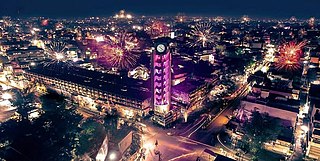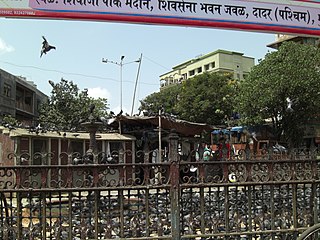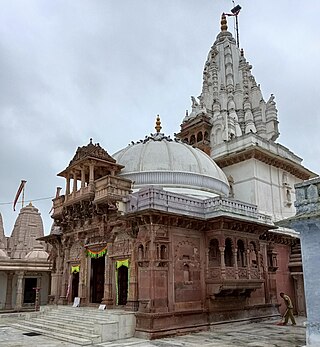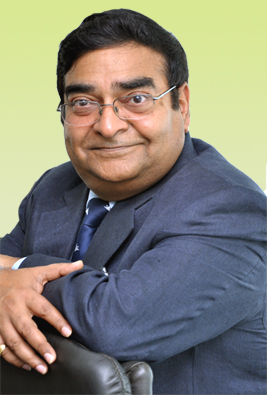
Jalgaon is a city in Maharashtra, India. The city is located in North Maharashtra in the subregion of Khandesh, and serves as the administrative headquarters of its namesake district, the Jalgaon district. The Girna river flows from the western part of the city. Jalgaon is colloquially known as the "Banana city of India" as the region's farmers grow approximately two-thirds of Maharashtra's banana production.

Dadar ([d̪aːd̪əɾ]) is a densely populated residential and shopping neighbourhood in Mumbai. It is also a prominent railway and bus service hub with local and national connectivity. It is Mumbai’s first planned area and it a hub for the city's Marathi culture.
Vile Parle (IPA:[ʋilepaːɾle], also known as Parla), is a suburb and also the name of the railway station in the Western suburb of Mumbai. Vile Parle has a significantly strong base of Gujarati and Marathi population. It serves as the location of the first Parle factory which ceased operations in the year 2016. It also houses Terminal 2 (T2) of Mumbai's Chhatrapati Shivaji Maharaj International Airport.

Virar is a coastal city in taluka Vasai and district of Palghar, in India's Maharashtra state. It is clubbed into Vasai-Virar city, administered by Vasai-Virar Municipal Corporation. It lies in south part of Palghar District in Vasai Taluka and north to the city of Mumbai. It is an important part of Palghar District because Palghar is the outermost part of northern side of Mumbai Metropolitan Region and comes under Police Jurisdiction of Mira-Bhayander, Vasai-Virar Police Commissionerate.
Chaibasa is a town and a municipality in West Singhbhum district in the state of Jharkhand, India. Chaibasa is the district headquarters of West Singhbhum district. It is also the headquarter of Singhbhum Kolhan division headed by the Divisional commissioner.
Nagda is an industrial town in Ujjain district of the Indian state of Madhya Pradesh. It lies in the administrative headquarters of the city of Ujjain, in the Malwa region of western Madhya Pradesh. It is situated on the bank of the Chambal River.

Kumbhoj is the name of an ancient town located in Kolhapur district in Maharashtra. The town is about eight kilometers from Hatkanangale, about twenty seven kilometers from Kolhapur and currently, also is the Taluka or Tehsil Headquarters. The famous Jain Tirtha known as Bahubali, is just two kilometers away from the Kumbhoj city.

Valsad district is one of the 33 districts in the Western Indian state of Gujarat. It is bound by Navsari district to the north, Nashik district of Maharashtra state to the east, and Dadra and Nagar Haveli district of the Dadra and Nagar Haveli and Daman and Diu (DNHDD) union territory and the Palghar district of Maharashtra to the south. The Arabian Sea lies west of the district. The coastal Damaon enclave of DNHDD is bounded by Valsad district on the north, east, and south. The district's administrative capital is Valsad. The district's largest city is Vapi.
Gogunda is a town and tehsil headquarters of Gogunda Tehsil in Udaipur district, located about 35 km (22 mi) in north-west from Udaipur city in the Indian state of Rajasthan. It is situated on a high mountain in Aravalli hills and is reached by crossing a difficult mountain pass.

Jainism has been present in Maharashtra since ancient times. The famous Ellora Caves demonstrate that Jainism was part of a thriving religious culture in Maharashtra in premodern times.

Dapoli is a town in Ratnagiri district, Maharashtra which is also a coastal hill station. It lies 215 km (134 mi) south of the state capital of Mumbai. the town is also known as Camp Dapoli, as the British had set their camps here. Many high-ranking British officers' graves are found in this town. There is also an abandoned church from the time of the British Raj. Dapoli is administered by a Municipal Council.

Dahanu is a coastal town and a municipal council in Palghar district of Maharashtra state in Konkan division. It is located 110 km from Mumbai city and hosts Adani Power’s thermal power station. It is the site of the approved Vadhawan Deep Water Port.

Maksi is a city and a municipality in Shajapur district in the Indian state of Madhya Pradesh. It is famous for Jain Temple of Maksi Parshwanathh Ji. Maksi has an ever buzzing market which is famous for sweet samosas.

Lohagad is one of the many hill forts of Maharashtra state in India. Situated close to the hill station Lonavala and 52 km (32 mi) northwest of Pune, Lohagad rises to an elevation of 1,033 m (3,389 ft) above sea level. The fort is connected to the neighboring Visapur fort by a small range. The fort was under the Lohtamia empire for the majority of the time, with a short period of 5 years under the Mughal empire.

Chandwad (IPA:Cāndavaḍa) is a town located in the Nashik district in Maharashtra. It is 250 km from Mumbai. The 11th-century Jain Caves, Renuka devi mandir, Chandreshwar temple and Rangmahal are in Chandwad.

Maharashtra attracts tourists from other Indian states and foreign countries. It was the second most visited Indian state by foreigners and fifth most visited state by domestic tourists in the country in 2021. Aurangabad is the tourism capital of Maharashtra.

Attoor is a panchayat town in Kanniyakumari district in the Indian state of Tamil Nadu.
Ganj Basoda, called Basoda, city and municipality in the Indian state of Madhya Pradesh. Ganj Basoda is one of the eleven tehsils of Vidisha district and is 39 km from Vidisha.

Dr Mukesh Batra is the founder of Dr Batra's group of companies, a chain of homeopathy clinics in 6 countries and an FMCG brand. He is a first generation entrepreneur, the author of books on homeopathy, and writer of health columns in publications such as The Times of India. He was awarded the Padma Shri award for homeopathic medicine in 2012. Dr. Mukesh Batra is widely known for using modern technology to bring standardization to "homeopathic healthcare solutions". He is regarded by some as the pioneer of modern homeopathy in India. He started the World's first branded and computerized homeopathy clinic in 1982. He also introduced the blister-packaging of homeopathic remedies.
The Weeping crucifix in Mumbai is a statue of the crucified Jesus in Mumbai (Bombay) which attracted widespread attention in 2012; when a constant stream of water began to seep from its feet. Some of the local Catholic Christians believed the incident to be a miracle; a skeptic-rationalist and atheist author by the name Sanal Edamaruku, provided evidence that the water stemmed from a faulty sewage system, which seeped due to capillary action. However, Edamaruku also accused Latin Christian priests of regularly scamming devotees and defrauding miracles to make money inorder to build bigger and newer churches or convents, and mocked the Pope as "anti-science". A church representative admitted Edamaruku had the "right to doubt" & Christian activists said that the backlash was not for debunking the alleged "miracle", but for the defamatory statements made on live television. After which he became subsequently subject to multiple first information reports (FIR) under blasphemy laws. A Catholic lawyer and the Roman Catholic Archdiocese of Bombay called for him to apologise for the comments. After receiving a barrage of threats, he migrated to Finland to avoid being arrested under the blasphemy law.














